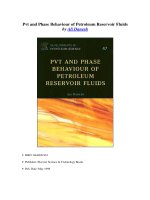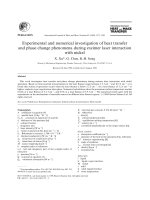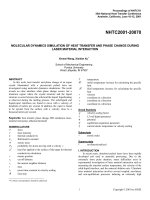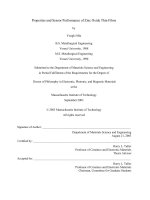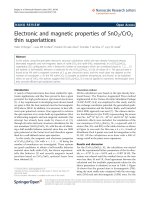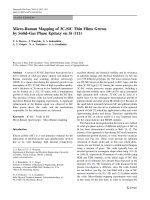Long range and short range orders, and phase miscibility of cocrpt ti thin films
Bạn đang xem bản rút gọn của tài liệu. Xem và tải ngay bản đầy đủ của tài liệu tại đây (4.09 MB, 129 trang )
LONG-RANGE AND SHORT-RANGE ORDERS, AND PHASE
MISCIBILITY OF CoCrPt/Ti THIN FILMS
SUN CHENGJUN
(B. Eng. Liaoning Institute of Technology, P. R. China
M. Eng. Dalian Railway Institute, P. R. China)
A THESIS SUBMITTED
FOR THE DEGREE OF DOCTOR OF PHILOSOPHY
DEPARTMENT OF MATERIALS SCIENCE
NATIONAL UNIVERSITY OF SINGAPORE
2004
Acknowledgements
i
Acknowledgements
I would like to express my heartfelt thanks to my thesis advisors, Associate
Professors Gan-Moog Chow and Jian-Ping Wang, for their guidance, inspiration and
encouragement throughout the course of my research. I have benefited from their
expertise in all aspects of scientific research. I am grateful for their commitment in
providing their student broad experience from which I will benefit in my future
research.
I deeply appreciate the advice and help from Mr. Eng-Wei Soo. His expertise
helped me in my research. I also had invaluable help from Professor J. H. Je,
Professor S. W. Han, Dr. Y. K. Hwu, and Professor D. Y. Noh.
I would like to thank the faculty of the Department of Materials Science and
the faculty fellow scholars of the Media and Materials groups, and Data Storage
Institute. I would also like to thank Professor Zhensheng Shan, Ms. Siew It Pang,
Ms. Shiaw Kee Chow, Dr. Lianjun Wu, and Mr. Daoyang Dai for their advice and
kind assistance.
Finally, I especially thank my wife, Ms. Minjie Liu, for her support,
encouragement and sacrifice.
Contents
ii
Table of Contents
Acknowledgements………………… …………………………………………….….i
Summary
………………… ………………………………………………… ………vi
List of Tables
……… ………………………………………………… ………… viii
List of Figures
……… ……………………………………………… … ……… ix
List of Symbols
……… ……………………………………………… … xii
List of Abbreviations…………………………………………… … xiv
I Introduction……………………… ……………………………………………….1
1.1 Media requirements for high areal density magnetic recording …… ……….2
1.1.1 Signal to noise ratio……………………………………………….2
1.1.2 Thermal stability ………………………………………………….3
1.1.3 Consideration of perpendicular magnetic recording………………4
1.2 General properties of perpendicular CoCrPt thin films………………………6
1.2.1 High magnetocrystalline anisotropy. ……………………………6
1.2.2 Effects of Cr on the saturation magnetization of CoCr …… ….6
1.2.3 Effects of Cr and Co phase segregation … ……… ………… 7
1.2.4 Effects of Pt on coercivity ………………………………… … 8
1.3 Research Aspects and objectives…… ….…………………………….… 9
1.3.1 Research Aspects ……………………………………………… 9
1.3.1.1 Research Aspect -1: NiP seedlayer… … …… …… 11
Contents
iii
1.3.1.2 Research Aspect -2: Ti underlayer…… ……………….14
1.3.1.3 Research Aspect -3: Ti and CoCrPt interface……………18
1.3.1.4 Research Aspect -4: CoCrPt magnetic layer…………… 22
1.3.2 Objectives of this study…………………………………… ….31
1.4 Outline of the thesis………… ….…………………………………….… 32
II Experimental Techniques. ……………………… ……………….….…… 34
2.1 Sputtering…………….…………….………………………………… ………34
2.1.1 Introduction to sputtering. ……………………….…….……… …… 34
2.1.2 Sputtering fundamentals ………………………………………………35
2.1.3 Magnetron sputtering ………………………………………………….36
2.2 X-ray scattering. ………………………….…… …………….…………….…37
2.2.1 The Bragg Law …………….………………………………………….37
2.2.2 Reciprocal space geometry. ……………… …….……………………38
2.2.3 Powder diffraction ………….…………………………………………40
2.2.4 Mosaic distribution………………………………………………….…41
2.3 Extended x-ray absorption fine structure …………………………………… 42
2.3.1 Introduction to x-ray absorption fine structure………………….…… 42
2.3.2 Origin of EXAFS …………………………………………………… 43
2.3.3 Theory of EXAFS and SRO…….…………………………… ………44
2.4 Anomalous x-ray scattering ……………………………………………… …48
2.4.1 Introduction to AXS…….…………………………………………… 48
2.4.2 Origin and theory of AXS……………….…………………………… 49
2.4.3 AXS measurement geometry …… ……………………………….….51
Contents
iv
2.4.4 Comparisons of EXAFS and AXS…………………………………… 52
2.4.5 Phase miscibility and AXS ………….……………………………… 53
2.5 Vibrating sample magnetometer and alternating gradient force magnetometer.54
2.5.1 Vibrating sample magnetometer ……… ……….…….…………… 54
2.5.2 Alternating gradient force magnetometer……… …… ………… …55
III Effects of NiP Seedlayer on CoCrPt/Ti Thin Films …… ……… …57
3.1 Sample preparation and characterizations …………………………….………57
3.2 Magnetic properties ….…… ……….………………….…………………….58
3.3 Structural characterization. ………………….………… ………….……… 60
3.4 Grain size and grain size distribution………………………………………… 63
3.5 Summary ………………………………………………………………………67
IV Interface Effects of CoCrPt/Ti Thin Films …………………………… 68
4.1 Sample preparation and characterizations …… ………… …….………….68
4.2 Magnetic properties ……………………….………………………….……….69
4.3 Structural characterization by XRD ……………………………….…… … 71
4.4 Structural characterization by TEM ………………………………………… 75
4.5 Summary …………………………………………… …………….……….…78
V Long-range and Short-range Orders, and Phase Miscibility of
CoCrPt/Ti Thin Films
…………………………………………… …… ….79
5.1 Sample preparation and characterizations.….………………………… …….80
5.2 Magnetic properties …………………….…………………………………… 81
5.3 Long-range order of CoCrPt films …….…………….…………………… ….83
5.4 Short-range order of CoCrPt films ……………………………………….……86
Contents
v
5.5 Phase miscibility of CoCrPt films ……………………………………… … 90
5.5.1 Anomalous x-ray scattering intensity and its measurements……… …90
5.5.2 Phase miscibility of Cr in CoCrPt films……………………… …… 93
5.5.3 Phase miscibility of Pt in CoCrPt films………………………….…… 96
5.5.4 Phase miscibility of Co in CoCrPt films………………………………100
5.6 Summary…………………………………………………………………… 101
VI Conclusions and Future Work ………… …………… ……………… 102
6.1 Conclusions ………………………………………………….…… …… …102
6.2 Future work ……………………………………………………….………….103
References…………………….……………………………………….…………… 106
List of Publications……………………… ……………………….…………… 113
Summary
vi
Summary
In this thesis, the nanoscale layer engineering approaches, including the effect
of NiP seedlayer on grain size and grain size distribution and the interface effect of
CoCrPt/Ti thin films, were addressed. Furthermore, the long-range order (LRO)
relationships between a CoCrPt magnetic layer and a Ti underlayer were investigated
by using x-ray scattering. The short-range order (SRO), of Co, Cr, and Pt in CoCrPt
films was studied by extended x-ray absorption fine structures (EXAFS). The phase
miscibility of Co, Cr and Pt in crystalline CoCrPt (002) was analyzed by anomalous
x-ray scattering (AXS).
In order to achieve small and uniform grains and modify magnetic properties
of CoCrPt films for high areal density magnetic recording, the effects of NiP
seedlayer on the microstructure and magnetic properties of CoCrPt/Ti film were
investigated. NiP was effective in reducing the grain size and improving the size
distribution of the grains by enhancing the grain isolation of the layers deposited on
top of it. A thin layer of NiP also improved the magnetic properties.
The structure and interface of CoCrPt/Ti films were studied using x-ray
scattering and transmission electron microscopy (TEM). At higher sputtering
pressure, the lower kinetic energy of ions reduced their mobility and ability to mix
with Ti, thus resulting in deposits on a well defined, abrupt interface. The roughness
of the Ti surface promoted the growth of a more distinct columnar structure with
small grain size and better isolation. The distinct columnar structure, with small and
well-isolated CoCrPt grains, resulted in a decrease of exchange coupling between the
Summary
vii
magnetic grains. The reduced exchange coupling contributed to the higher out-of-
plane coercivity. It was concluded that the improved out-of-plane coercivity and
squareness resulted from the combined effects of higher crystallinity and better
texture of the CoCrPt (002) film, and increased interface roughness.
The LRO and SRO and phase miscibility of CoCrPt/Ti films were
investigated with synchrotron x-ray scattering, EXAFS and AXS. The crystallinity
and texture of the CoCrPt magnetic layer followed the crystallinity and texture of the
Ti underlayer that could be optimized. Improved magnetic properties resulted from
the higher crystallinity and better texture of the CoCrPt (002), which was enhanced
by the increased disorder of Cr and Pt at the grain boundaries. It was found that Cr
and Pt were fully separated from the Co phase at the grain boundaries independent of
the Ti underlayer. Direct evidence of Pt not being found within the Co lattice was
given.
List of Tables
viii
List of Tables
Table 1.1 Lattice parameters of Co and Ti…………………………………………… 16
Table 1.2 Comparisons of different techniques for structural characterization………….27
Table 5.1 Fit parameters of both the first main peak around a Co absorber, fixing the
S
0
2
=0.778 as in bulk Co, and the main peak around a Cr absorber, fixing the
S
0
2
=0.824 as in bulk Cr. N, R and
σ
2
represent coordination number, distance,
and Debye-Waller factor, respectively. (N=12 for the first shell of Co-foil, and
N=8 for the first shell Cr-foil)…………………………… ……… ……… 87
List of Figures
ix
List of Figures
Fig.1.1 The requirements of media materials for high-density magnetic recording…… 5
Fig.1.2 Ms vs. Cr content for CoCr film. ………….………….…………….…………….7
Fig.1.3 Schematic graph of Co rich grain and Cr rich grain boundary……………………8
Fig.1.4 Structure of the CoCrPt/Ti/NiP media films ………….…………… …………10
Fig.1.5 AFM images of CoCrPtTa/Cr/NiP and CoCrPtTa/Cr showing the surface
topography….……………………………………………………………………12
Fig.1.6 Research Aspect -1: NiP seedlayer ………………………………………… 13
Fig.1.7 Road map of Research Aspect –1.………… ………… ……….………… …14
Fig.1.8 Research Aspect-2: Ti underlayer……….………… ………………………… 14
Fig.1.9 (a) A schematic diagram of the lattice planes of Si (111), Ag (111), Ti (0001), and
Co (0001) viewed from Si and [111], and Co and Ti [0001] directions, every
corner and center of the hexagonal lattice represent a given atom; (b) The
designed structure of the thin films…… …………………… …………………16
Fig. 1.10 Scan spectra of x-ray pole figures. (a) {110} poles for single crystal Si (111);
(b) {110} poles for Ag (111);(c){1,0, -1,1} poles for Ti (0002); and (d) {1,0, -
1,1} poles for CoCrPt (0002)………………………………………………… 17
Fig.1.11 Road map of Research Aspect –2…………………………… ……………….18
Fig.1.12 Research Aspect-3: CoCrPt & Ti interface …… ……………… …… …. 19
Fig.1.13 Road map of Research Aspect –3………………………………… ……….….21
Fig.1.14 Research Aspect-4: CoCrPt magnetic layer …………………………… … 22
Fig.1.15 Step model of alternating blocks of atomic planes of materials A and B,
respectively………………………………………………………………… 24
Fig.1.16 A schematic diagram of individual contributions of Eq.1-6……….…… … 25
Fig.1.17 Conventional XRD and phase identification………………………………… 26
Fig.1.18 (a) XRD powder scans of Ni
50
Co
50
. (b) XRD powder scans of Ni
90
Co
10
…… 28
Fig.1.19 (a) AXS results of Ni
50
Co
50
and Ni
90
Co
10
, Ni K-absorption edge. (b) AXS results
of Ni
50
Co
50
and Ni
90
Co
10
, Co K-absorption edge…………………………… 28
Fig.1.20 Metastable phase diagram of the Co-Cr system obtained when the sigma phase
(σ) is not taken into account (full lines) and stable equilibrium phase diagram
(dashed lines). Filled square from the sputtered film, hollow square from the
bulk alloy. A miscibility gap between Co-rich hcp ferromagnetic phase (hcp
f
)
and Co-poor hcp paramagnetic phase (hcp
p
) can be seen between 410 and 760
K……………………………………………………………………………… 30
Fig.1.21 Road map of Research Aspect –4…………………………… ………….….…31
Fig.2.1 Schematic diagram of sputter coating process………………………………… 35
Fig.2.2 Diffraction of x-ray by a crystal…………………………………………………37
Fig.2.3 The Ewald sphere construction in reciprocal space…………………………… 39
Fig.2.4 The accessible area (allowed reflections) shown in reciprocal space for a Cu
single crystal with (111) surface using Cu K
α
radiation, incident beam in (-1,1,0)
plane………………………………………………………………… …………40
Fig.2.5 The powder diffraction experiment. (a) Reciprocal space notation. The Ewald
sphere (dash line) is fixed, and the lattice is rotated all angels about the origin.
List of Figures
x
Only the rotation about [100] is shown in this two-dimensional section.
Intersections with Ewald sphere define the diffracting conditions. The dashed
arrow indicates the moment transfer. (b) The corresponding diffracted beams in
real space. ……… ………………………………………………………………41
Fig.2.6 The mosaic structure of a real crystal……………………………………………42
Fig.2.7 The photoelectron will be ejected with energy equal to energy of the incoming
photon less its binding energy, when in the core. This photoelectron will interact
with the surrounding atoms. A schematic diagram of the radial portion of the
photoelectron wave (solid lines) being backscattered by the neighboring atoms
(dotted lines)………………………………………………………………….….44
Fig.2.8 EXAFS spectrum of Co foil Standard………………………………… ……….46
Fig.2.9 Fourier transform amplitude of Co foil standard………………………… …….47
Fig.2.10 The anomalous scattering factor of Co near the Co K-edge……………………51
Fig.2.11 Schematic diagram of VSM……………………………………………………54
Fig.3.1 Coercivity as a function of Ti thickness (a) out-of-plane; (b) in-plane……….…59
Fig.3.2 Squareness as a function of Ti thickness (a) out-of-plane; (b) in-plane…………59
Fig.3.3 X-ray powder scans with different NiP thicknesses………………………… …60
Fig.3.4 Integrated intensity of CoCrPt (002) and FWHM as a function of NiP
thickness………………………………………………………………………….61
Fig.3.5 X-ray χ rocking curves at CoCrPt (002) with different NiP thicknesses… … 61
Fig.3.6 Crystal domain size as a function of NiP thickness………………………….… 62
Fig.3.7 AFM image for NiP layer………………… ……………………………….… 64
Fig.3.8 AFM image for Ti/NiP layers…………………………………………….…… 64
Fig.3.9 Planar-view TEM image for CoCrPt/Ti………………………………….… ….65
Fig.3.10 Planar-view TEM image for CoCrPt/Ti/NiP……………………………….… 65
Fig.3.11 AFM images with their invert for CoCrPt/Ti films with and without NiP
seedlayer…………………………………………………………………….…66
Fig.3.12 Grain size distribution estimated using inverted AFM images for media without
NiP seedlayer………………………….……………………………………….67
Fig.3.13 Grain size distribution estimated using inverted AFM images for media with 5
nm NiP seedlayer…………….……… …………………………………… 67
Fig.4.1 (a) Out-of-plane coercivity and squareness as a function of Ar pressure, and (b)
in-plane coercivity and squareness as a function of Ar pressure………………70
Fig.4.2 X-ray powder scans as a function of Ar pressure……….……………………….72
Fig.4.3 X-ray χ-rocking curve of the CoCrPt (002) peak as a function of Ar pressure…73
Fig.4.4 The integrated intensity of the powder scan and FWHM of χ rocking curve of the
CoCrPt (002) peak as a function of Ar pressure…………………………………74
Fig.4.5 Dark-field TEM micrographs of planar CoCrPt films at different Ar pressures (a)
3 mTorr, and (b) 7 mTorr……………………………………………………… 76
Fig.4.6 Dark-field TEM micrographs of cross-sectional CoCrPt films at different Ar
pressures (a) 3 mTorr, and (b) 7 mTorr. The white double-head arrow indicates
the extent of Ti underlayer…………………………………………………….…77
Fig.5.1 (a) Coercivity as a function of Ti thickness…… …………………… ………81
Fig.5.1 (b) Squareness as a function of Ti thickness………… …….………………… 82
Fig.5.2 (a) Coercivity as a function of Ti thickness…… ………………………………82
Fig.5.2 (b) Hyeteresis loops of CoCrPt film with 30 nm Ti underlayer ………… 83
List of Figures
xi
Fig.5.3 X-ray powder scans of the magnetic films with different thickness Ti underlayer,
…………………………………………………………… …………………….84
Fig.5.4 The integrated intensity of Bragg peaks as a function of Ti thickness……….….85
Fig.5.5 The FWHM of CoCrPt (002) and crystal domain size of CoCrPt films……… 85
Fig.5.6 Fourier transformed amplitude of Co EXAFS………………………………… 87
Fig.5.7 Fourier transformed amplitude of Cr EXAFS………………………………… 89
Fig.5.8 Fourier transformed amplitude of Pt EXAFS……………………………… … 89
Fig.5.9 The anomalous atomic form factors of Co K-, Cr K- and Pt L
III
-absorption edges
,
respectively. (a) imaginary part; (b) real part……………… ……….…………91
Fig.5.10 The simulation results of anomalous atomic form factors with various elemental
concentrations at the crystal…………………………………………………… 92
Fig.5.11 AXS spectra of the (002) peak in the vicinity of Cr absorption K-edge…….…95
Fig.5.12 Phase diagram of Co-Pt binary alloy phase diagram………………………… 97
Fig.5.13 AXS spectra of the (002) peak in the vicinity of Pt absorption L
III
-edge………99
Fig.5.14 AXS spectra of the (002) peak in the vicinity of Co absorption K-edge …… 100
List of Symbols
xii
List of Symbols
1. BV-bit volume.
2. d-the interplaner spacing of the diffracting plane
3. D-average grain size
4.
()
qf -atomic scattering factor
5. ),( Eqf
Co
-Co atomic form factor
6. ),( Eqf
Cr
-Cr atomic form factor
7. ),( Eqf
Pt
-Pt atomic form factor
8. )(
'
Ef -the real component of anomalous dispersion term
9. G-the scattering vector
10. H
c
-coercivity
11. H
k
-anisotropy field
12.
()
EqI , -the scattering intensity
13. )(
"
Eif -the imaginary component of anomalous dispersion term
14. K-the scattered beam vector
15. K
0
-the incident beam vector
16. k
B
-the Boltzmann constant
17. K
u
-anisotropy constant
18. M
s
-saturation magnetization
19.
a
N -demagnetization factor along the crystalline easy axes
List of Symbols
xiii
20.
b
N -demagnetization factor along the crystalline hard axes
21. q
z
-the momentum transfer parallel to the surface normal
22. T –absolute temperature
23. V -magnetic switching volume
24.
σ
-grain size distribution
25.
τ
- relaxation time
26. λ- wavelength
27. θ -the angle of the incidence and of the diffraction of the radiation relative to
the reflecting plane
28.
Co
χ
-Co elemental concentration at the specified Bragg reflection
29.
Cr
χ
-Cr elemental concentration at the specified Bragg reflection
30.
Pt
χ
-Pt elemental concentration at the specified Bragg reflection
List of Abbreviations
xiv
List of Abbreviations
1. AFM-atomic force microscopy
2. AGFM-alternating gradient force magnetometer
3. AXS-anomalous x-ray scattering
4. EXAFS-extended x-ray absorption fine structure
5. fcc-face center cubic
6. FT-Fourier transform
7. FWHM -full width at half maximum
8. hcp-hexagonal close-packed
9. LRO-long-range order
10. MFM-magnetic force microscopy
11. NMR- nuclear magnetic resonance
12. PLS-Pohang light source
13. PNC-CAT-Pacific Northwest Consortium-Collaborative Access Team
14. SNR-signal-to-noise ratio
15. SRO-short-range order
16. TEM-transmission electron microscopy
17. VSM-vibrating sample magnetometer
18. XANES-x-ray absorption near edge structure
19. XAS-x-ray absorption spectroscopy
20. XMCD-x-ray magnetic circular dichroism
List of Abbreviations
xv
21. XRD-x-ray diffraction
Chapter I Introduction
1
Chapter I
Introduction
The magnetic disk drive that featured a total storage capability of 5 MB at a
recording density of 2 Kbit in
-2
was invented at IBM in 1956. Since then, the areal
density for information storage on magnetic media, especially hard disk memory, has
increased more than 20 million-fold in modern disk drives. This was evident in two
recent lab demonstrations of recording densities beyond 100 Gbit in
-2
.
1
The high-
speed progress of magnetic recording was associated with the rapid development of
the magnetic thin media films. The continuing increase of recording density requires
small and isolated grains to provide enough signal-to-noise ratio (SNR) at high areal
density, which is limited by the thermal effect in longitudinal media. Compared to the
longitudinal media, perpendicular media with high anisotropy have higher thermal
stability, resulting in 2-9 times greater areal density.
2
Note that CoCr-based granular
thin film was used in the first implementation of the perpendicular recording
system.
3,4
The correlations between structural and magnetic properties of magnetic thin
films fall within the domain of materials science. A better basic understanding of
magnetic thin films, such as the degree of alloying and phase separation of these
films, may provide a future guide for new materials development. The work
presented in this thesis was a study of the long-range order and short-range order, and
Chapter I Introduction
2
phase miscibility of CoCrPt/Ti thin films. In this chapter, we shall review the media
requirements for high areal density magnetic recording, general properties of
perpendicular CoCrPt thin films, and research aspects and objectives of this study. At
the end of this chapter, the outline of the thesis is given.
1.1 Media requirements for high areal density magnetic
recording
1.1.1 Signal to noise ratio
To achieve high areal density magnetic recording, it is necessary to use a
magnetic recording configuration capable of writing the signal to a bit and a signal
processing system capable of recovering data reliably. Therefore the ratio of single-
pulse peak over integrated transition noise power,
5
defined as SNR, is an important
figure of merit in magnetic recording. The higher the SNR, the easier the data can be
detected. Magnetic recording media are required to provide a high SNR and remain
thermally stable over a long period of time in high areal density magnetic recording.
6
For media films, the SNR is proportional to the read track-width and the square of the
bit length.
5
In high-density magnetic recording, small
7
and uniform
8
grains are
demanded to achieve a high SNR.
The SNR, by grain-counting argument,
7
is approximated by the number of
magnetic grains (or switching units) per bit:
g
V
BV
SNR ∝
(1-1)
Chapter I Introduction
3
where
BV: bit volume
V
g
: the grain volume
Equation 1-1 indicates clearly that the larger the number of grains in a bit, the higher
the SNR can be achieved. Therefore, a small grain size is required in order to
maintain the number of grains per bit in high areal density magnetic recording media
films.
In addition, the SNR does not only depend on the average grain size D, but
also the width of grain size distribution
σ
.
8
Decreasing
σ
increases SNR. If grains are
not uniform, the big magnetic grain may cause large zigzag regions between two
recording bits, and result in a strong interaction between the magnetic grains. As a
result, uniform grains could improve SNR as depicted in Equation 1-2.
8
+
∝
2
3
1
1
D
D
SNR
σ
(1-2)
1.1.2 Thermal stability
The decreasing grain size could result in thermal instability of the recording
media. In order for the magnetization in a recording medium to be stable over a long
period of time, the energy barrier K
u
V must be much larger than the thermal energy
k
B
T, where K
u
, V, k
B,
T are anisotropy constant, magnetic switching volume,
Boltzmann constant, and absolute temperature, respectively. The relaxation time
τ
is
an exponential function of the grain volume.
9
Chapter I Introduction
4
=
−
Tk
VK
B
u
exp10
9
τ
(1-3)
For the recording information that will be stable for several years (for
example, 7.5 years is used as a conventional benchmark), it requires that
TkVK
Bu
40> .
10
The volume V of a magnetic grain typically decreases with
increasing areal density due to the reason discussed before; hence higher K
u
materials
are needed to maintain sufficient stability. Note that the grain size cannot be infinitely
decreased because thermal instability will eventually set in below a critical grain size.
As a result, the limitation of magnetic recording is determined by the decay of SNR
due to thermally induced magnetization fluctuation.
1.1.3 Consideration of perpendicular magnetic recording
For media materials, it is proposed that rather thick media films can be used
for perpendicular media, contrary to the requirements of the longitudinal media.
6
As a
consequence, perpendicular media films with small grain size and larger thickness
could be applied within the thermal stability limitation, resulting in high areal density
in perpendicular recording media films.
Perpendicular magnetic recording could realize ultra-high areal density
recording. Simulation works pointed out that the areal density of perpendicular
recording media can be extended to above 1000 Gbit in
-2
.
11
The advantages of
perpendicular recording are summarized as follows:
• Transitions formed in perpendicular recording are more stable and sharper
than that in longitudinal recording and media with high anisotropy constant
Chapter I Introduction
5
can be used in perpendicular recording, indicating the ability of higher
recording density for perpendicular recording.
• If a recording system with a single pole recording head system is applied, the
strength of the magnetic writing field acting on the media to record signals is
about twice that of longitudinal recording, thus favoring higher recording
density for perpendicular recording.
12
• The track edge is very sharp in perpendicular recording while there exists a
wide erase band in longitudinal recording caused by the side effect of the ring
type recording head. The sharp track edge with perpendicular recording
allows for a high track density or high recording density.
13
In summary, as illustrated in Figure 1.1, the future media requirements for high
areal density magnetic recording could be the perpendicular magnetic recording
media with high anisotropy constant and small, uniform, and isolated grains.
Figure 1.1. The requirements of media materials for high-density
magnetic recording.
Uniform grain
Media requirements for
high-density recording
High SNR
Thermal stability
SNR
∝
BV/V
g
BV: bit volume
V
g
: the grain volume
τ
=10
-9
exp(K
u
V/k
B
T)
K
u
V: the energy barrier
k
B
T : thermal energy,
Small grain
High K
u
Large V
D: average grain size
σ
: grain size distribution
+
∝
2
3
1
1
D
D
SNR
σ
Isolated grain
Perpendicular
recording media
Chapter I Introduction
6
1.2 General properties of perpendicular CoCrPt thin films
The hexagonal close-packed (hcp) CoCr-based media films were first
proposed for perpendicular magnetic recording by S. Iwasaki in 1978.
14
The general
properties of perpendicular CoCrPt thin films are discussed below.
1.2.1 High magnetocrystalline anisotropy (K
u
)
One reason that CoCr was first proposed for perpendicular recording was that
Co has a large magnetocrystalline uniaxial anisotropy (
6
105.4 × erg/cm
3
);
15
hence it
can be used to develop the perpendicular media films.
14
1.2.2 Effects of Cr on the saturation magnetization (M
s
) of CoCr
The most crucial criterion for perpendicular recording films is that the
anisotropy field
H
k
(the effective magnetic field that tends to align the magnetization
to be parallel to the easy axis) of the film must surpass the maximum demagnetizing
field
4
π
M
s
(caused by the recorded magnetization itself). It is therefore necessary to
add other materials to reduce
M
s
. According to the literature, CoCr alloys have a
relatively stable
hcp phase at a low Cr content at room temperature and, at the same
time, the saturation magnetization is expected to decrease when a small amount of Cr
is added (Fig. 1.2).
Chapter I Introduction
7
0 5 10 15 20 25
0
200
400
600
800
1000
1200
1400
1600
o
o
o
o
o
o
o
o
o
oo
o
o
o
o
o
o
CoCr film
CoCr bulk
Saturation magnetization (emu/cm
3
)
Cr content (at. %)
1.2.3 Effects of Cr and Co phase segregation
The exchange coupling reflects the degree of grain interaction between the
adjacent crystalline grains in the films. Small grains result in strong exchange
coupling because the distance between neighboring grains is short. In CoCr-based
perpendicular magnetic thin films, a simulation study showed that the reduced
coercivity (
H
c
/H
k
) almost linearly decreased with increasing exchange coupling.
16
It
is challenging to decrease exchange coupling at high-density recording media with
small grains. The compositional inhomogeneities in CoCr-based media are
responsible for many of the desirable recording characteristics. The regions between
Figure 1.2. M
s
vs. Cr content for CoCr film. (Adapted from S.
Iwasaki and K. Ouchi, 1978,
Ref. 14).
Chapter I Introduction
8
magnetic crystalline grains are believed to affect strongly the exchange coupling
between magnetic grains. In Co-Cr alloys, phase segregation formed the Co-rich
magnetic core and Cr-rich non-magnetic grain boundary to decrease the exchange
coupling between magnetic grains.
17
As a result, a magnetically isolated grain (Fig.
1.3) could act as a single grain particle, increasing the signal to noise ratio
17
and
coercivity.
16
1.2.4 Effects of Pt on coercivity (H
c
)
The perpendicular coercivity of the thin film is the reversal magnetic field at
zero perpendicular mean magnetization. The mean interaction field is zero at the
coercive state. Generally speaking, high coercivity is derived from high magnetic
anisotropy. For an isolated single domain particle, the coercivity based on the Stoner-
Wohlfarth model
18
is
])(1[
K
s
abkc
H
M
NNHH −+=
(1-4)
where
a
N and
b
N are demagnetization factors along the crystalline easy and hard
axes, respectively. Pt has been shown to increase the coercivity of CoCr film,
19
thus
Co rich grain
Cr rich grain boundary
Figure 1.3. A schematic diagram of Co rich grain and Cr rich grain boundary.
Chapter I Introduction
9
improving thermal stability (Eq.1-4). The increase of average grain size
20
and
increase of local disorders of Co
21
due to the addition of Pt were suggested for the
increase of coercivity.
To summarize, the above properties show that the
hcp CoCrPt thin films are a
promising media candidate for perpendicular magnetic recording.
1.3 Research Aspects and objectives
1.3.1 Research Aspects
Summarizing the previous sections, the future media requirements for high
areal density magnetic recording are perpendicular magnetic recording media with
high anisotropy constant and small, uniform, and isolated grains. The
hcp CoCrPt
media films are promising perpendicular magnetic recording media. The structure of
CoCrPt media film (Fig. 1.4) was investigated in this study.
In order to satisfy the requirements of high areal density recording, the desired
structural and magnetic properties are obtained by a designed layered-structure.
22
Each layer plays multiple roles. For instance, the seedlayer serves as a buffer
between the glass substrate and the underlayer.
23
The underlayer is to provide a
texture for the magnetic layer by controlling the preferred crystallographic
orientation. The intermediate layer is to relieve the lattice mismatch between the
magnetic layer and the underlayer,
24
and the antiferromagnetically coupled interlayer
is to further modify magnetic properties by antiferromagnetically coupling the top
with the bottom magnetic layers.
25
It was reported that the structural and magnetic
